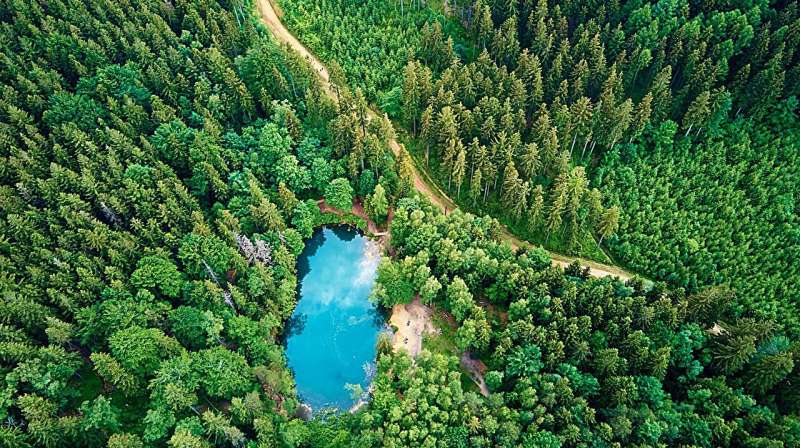This article has been reviewed according to Science X's editorial process and policies. Editors have highlighted the following attributes while ensuring the content's credibility:
fact-checked
peer-reviewed publication
trusted source
proofread
Scientists map biodiversity changes in the world's forests

A group of EPFL and ETH Zurich scientists have mapped the biodiversity in forests worldwide. Their data, when combined with climate projections, reveal trends that could support ecosystem conservation and restoration efforts.
According to the latest figures from the Food and Agriculture Organization of the United Nations, forests cover just over 4 billion hectares of the Earth's surface, or one-third of its total land. The benefits of forests are numerous: they provide raw materials, act as carbon sinks, help regulate the climate and protect the planet, provide a home for biodiversity, and serve as a source of well-being.
Yet the latest survey suggests that around 31% of tree species are threatened with extinction. Efforts are under way to build the resilience of forest ecosystems. But which parts of the world are experiencing the biggest changes? Which regions should be prioritized for protection? Which tree species are most resilient to the local impacts of climate change?
Scientists at EPFL have teamed up with colleagues at ETH Zurich to answer these questions and more. Their findings, published in Nature Communications, provide key insights for policymakers and planners, helping to guide sustainable forest management practices around the world.
Detailed distribution maps of over 10,000 tree species
For this study, co-led by EPFL's Environmental Computational Science and Earth Observation Laboratory (ECEO) and two research groups at ETH Zurich, scientists combined almost 26 million tree observations with geospatial data on climate and soil conditions as well as geographical dispersion constraints, which contain tree species within their reported native ranges.
"We wanted to avoid prediction errors, such as species that would be predicted to be found in a given location simply because the climate was suitable although they are invasive," says Nina van Tiel, a Ph.D. student at ECEO. For their sample, the team selected the 10,590 most widespread of the 73,000 known tree species on the planet, excluding rarer ones at this stage.
"We included trees with 90 or more recorded observations—the threshold above which our predictive models become sufficiently robust," explains van Tiel.
"This is the largest study of its kind in terms of scale and number of species," says Devis Tuia, an associate professor at ECEO. "Our findings provide an overview of forest biodiversity across the entire planet, not just in regions that are already well-documented."
The scientists also used their models to predict species distribution under different climate and temperature scenarios through to 2100.
"Predicting the future is always fraught with uncertainty, but the sheer number of species we included in our models gives us an idea of how biodiversity will shift in response to climate change," adds Tuia.
The data, compiled in map form, show the incredible diversity of forest ecosystems worldwide. The lines on the maps demarcate species with similar characteristics and genetic relationships. Each site is associated with a unique set of tree species and lineages—a result of historical and environmental factors.
"The overall findings are in line with our expectations," says Loïc Pellissier, an associate professor at ETH Zurich's Department of Environmental Systems Science. Using the maps, scientists can also calculate the area of habitat of different species around the world.
"As expected, species in boreal forests are distributed over large areas," explains Pellissier. "But our models also show that certain tropical trees have very wide ranges, which relates to the findings of hyperdominant species in the Amazon basin."
What threats do forests face?
Forest management is already a challenging endeavor. But the rapidly changing climate is altering the potential ranges of different plant species, making the task even more complex.
"Climate change is affecting species composition—in some regions, the climate may become unsuitable for over half of the species that may currently be found there, whereas in other regions, many new species may find suitable habitats in the future," says van Tiel.
The way tree species are responding to these changes varies considerably from one region to the next. Using statistical models, the research team mapped out suitable future ranges for different species.
"Our maps are by no means a finished product," says Tuia. "They'll need to be tweaked further in the future. But they provide vital information for forest conservation and restoration and underscore the urgent need for concrete measures to safeguard forest biodiversity."
The study highlights just how unique each of the world's forests is in terms of species composition, land-use history and the impacts of climate change.
"The findings give a big-picture view of forest ecosystems across the planet," says Thomas Crowther, an ETH Zurich professor whose lab worked with ECEO on the study.
"The data can be combined with local observations and expert knowledge to support conservation and restoration efforts." Lists of local tree species have already been added to Restor, a data platform developed by Crowther Lab.
More information: Nina van Tiel et al, Regional uniqueness of tree species composition and response to forest loss and climate change, Nature Communications (2024). DOI: 10.1038/s41467-024-48276-3
Journal information: Nature Communications
Provided by Ecole Polytechnique Federale de Lausanne





















